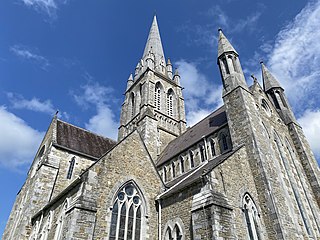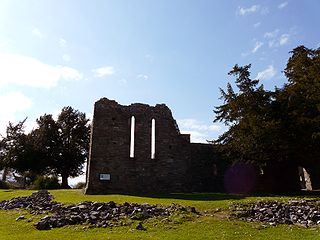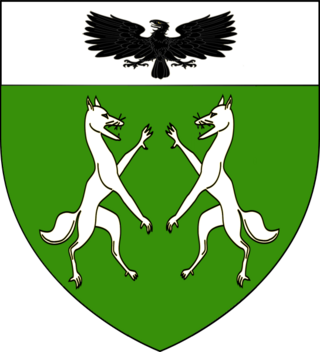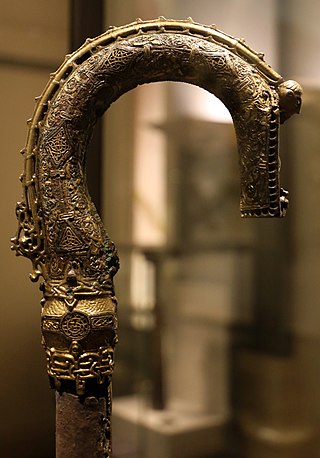
Killarney is a town in County Kerry, southwestern Ireland. The town is on the northeastern shore of Lough Leane, part of Killarney National Park, and is home to St Mary's Cathedral, Ross Castle, Muckross House and Abbey, the Lakes of Killarney, MacGillycuddy's Reeks, Purple Mountain, Mangerton Mountain, Paps Mountain, the Gap of Dunloe and Torc Waterfall. Its natural heritage, history and location on the Ring of Kerry make Killarney a popular tourist destination.

Innisfallen or Inishfallen is an island in Lough Leane; one of the three Lakes of Killarney in County Kerry, Ireland. Innisfallen is home to the ruins of Innisfallen Abbey.

The Ardfert Cathedral is a ruined cathedral in Ardfert, County Kerry, Ireland. Dedicated to Saint Brendan, it was the seat of the Diocese of Ardfert from 1117. It is now a heritage tourism site.

The Eóganachta were an Irish dynasty centred on Cashel which dominated southern Ireland from the 6/7th to the 10th centuries, and following that, in a restricted form, the Kingdom of Desmond, and its offshoot Carbery, to the late 16th century. By tradition the dynasty was founded by Conall Corc but named after his ancestor Éogan, the firstborn son of the semi-mythological 3rd-century king Ailill Aulom. This dynastic clan-name, for it was never in any sense a 'surname,' should more accurately be restricted to those branches of the royal house which descended from Conall Corc, who established Cashel as his royal seat in the late 5th century.

Lough Leane is the largest of the three lakes of Killarney, in County Kerry. The River Laune flows from the lake into the Dingle Bay to the northwest.

Aghadoe is a large townland overlooking the town and lakes of Killarney in Ireland. Officially it is also a parish, although the parish is larger than the area normally associated with the name. The area is famous for its views of the lakes and islands, including Innisfallen. The ruins of 13th century Parkavonear Castle and of Aghadoe Cathedral, an old Romanesque church in ruins, make the spot popular with tourists and archaeologists.

The O'Donoghue of the Glens, Prince of Glenflesk, is the hereditary chieftain of his sept of the Kerry Eóganacht, Munster, Ireland. In 1944, his father was one of the few Chiefs of the Name recognized by Edward MacLysaght, the first Chief Herald, as having a verifiable pedigree and entitled to use the title and receive courtesy recognition by the Irish State.

The Diocese of Limerick and Killaloe was a former diocese of the Church of Ireland that was located in mid-western Ireland. The diocese was formed by a merger of neighbouring dioceses in 1976, before itself merging with the neighbouring Diocese of Tuam in 2022 to form the Diocese of Tuam, Limerick and Killaloe.
Eóganacht Locha Léin or Uí Cairpre Luachra were a branch of the ruling Eóganachta of Munster. Their territory was in Iarmuman or West Munster. Luachair (Lúachra) is the old name of a large district on the borders of Co Cork, Kerry and Limerick. Cairbre of Sliobh Luachra was on the Cork-Kerry border; Eóganacht Locha Léin is around the Lakes of Killarney.
Áed Bennán mac Crimthainn was a possible King of Munster from the Eóganacht Locha Léin branch of the Eoganachta. He was definitely king of West Munster or Iarmuman. He was the great-grandson of Dauí Iarlaithe mac Maithni also a possible king of Munster from this branch His byname bennán means "horned," so it may refer to a spiked or horned helmet that he wore.
Máel Dúin mac Áedo was a possible King of Munster from the Eóganacht Locha Léin branch of the Eóganachta. He was the son of Áed Bennán mac Conaing, a king of Iarmuman or West Munster and great great grandson of Áed Bennán mac Crimthainn who may have been King of all Munster.
Ólchobar mac Duib-Indrecht was a supposed King of Munster from the Eóganacht Áine branch of the Eóganachta. His last paternal ancestor to hold the throne was Cúán mac Amalgado, five generations previous. His great-grandfather Uisnech had been the brother of another King Eterscél mac Máele Umai. According to a genealogical tract Uisneach was heir apparent to the Munster throne until slain by his brother through envy and hatred and then Eterscél assumed the kingship of Munster.
Artrí mac Cathail was a King of Munster from the Glendamnach branch of the Eóganachta. He was the son of Cathal mac Finguine, a previous king. He reigned from 793 to 820.
Iarmhumhain was a Kingdom in the early Christian period of Ireland in west Munster. Its ruling dynasty was related to the main ruling dynasty of Munster known as the Eóganachta. Its ruling branch was called the Eóganacht Locha Léin or Ui Chairpri Lúachra. Their center was around Killarney, County Kerry at Loch Léin. The name Iarluachair means west of the Sliabh Luachra mountains.
The Bishop of Limerick, Ardfert and Aghadoe was the Ordinary of the Church of Ireland diocese of Limerick, Ardfert and Aghadoe, which was in the Province of Cashel until 1833, then afterwards in the Province of Dublin.
Amlaíb Ua Donnubáin is the last member of the O'Donovan family to be styled king of Uí Chairpre Áebda in the Irish annals, and in fact the very last known king of this people.
Maelsuthan Ua Cerbhail, Maelsuthain O'Carroll, or Maelsuthain O'Cearbhail was a political and academic figure in medieval Ireland. He was lord of the Eóganacht Locha Léin, advisor to High King Brian Boru, and an important scholar often credited for beginning the Annals of Innisfallen. Maelsuthan's academic reputation was considerable, earning him accolades like "chief doctor of the Western world in his time" and "sage of Ireland."

The River Laune Crozier is a late 11th-century Insular crozier, now at the Archaeology branch of the National Museum of Ireland. The object would have been commissioned as a staff of office for a senior clergyman, most likely a bishop. It consists of a wooden core decorated with fitted bronze and silver metal plates. Although the metalwork is somewhat corroded in parts, it is fully intact and considered one of the finest surviving Irish examples, alongside those found at Clonmacnoise and Lismore.














